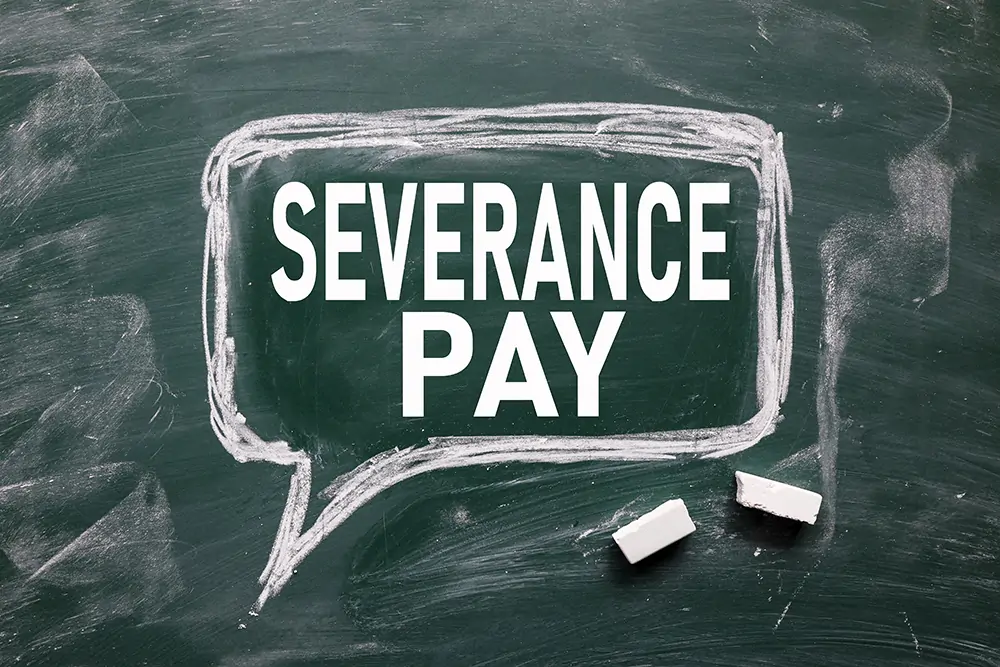Understanding the breakdown of Ontario’s severance pay is essential for employees. Furthermore, knowing your rights and entitlements regarding severance pay is crucial when facing job transitions. The Employment Standards Act (“ESA“) in Ontario provides clear guidelines on severance pay, which can serve as valuable financial support during such periods. One of the most useful tools in navigating these regulations is the Ontario Severance Pay Chart.
This blog post will explore the key factors that determine severance pay entitlements in Ontario, both under the ESA minimums and common law reasonable notice. We’ll discuss how to read and apply the Ontario Severance Pay Chart, as well as the importance of seeking legal advice to ensure you receive your full rightful compensation.
What is the Ontario Severance Pay Chart?
The Ontario Severance Pay Chart is essentially a representation of the minimum severance pay requirements under the ESA. This chart outlines the number of weeks of severance pay an employee is entitled to based on their tenure with the employer. While this chart provides a starting point to understand your rights, keep in mind that it only covers the minimums.
How to Read the Ontario Severance Pay Chart
The chart is straightforward and easy to interpret. It consists of two columns:
- one for the number of years of service and
- another for the corresponding weeks of severance pay.
For example, if you have worked for your employer for five years, the chart indicates that you are entitled to a minimum of five weeks of severance pay. See our severance calculator here for reference.
It’s important to note that the chart only applies to employees who have worked for their employer for at least five years and whose employer has a payroll of $2.5 million or more in Ontario. Additionally, the maximum number of weeks of severance pay under the ESA is capped at 26 weeks, regardless of the number of years of service beyond 26 years.
Beyond the Statutory Minimums – Common Law
Although the Ontario Severance Pay Chart sets a standard for severance pay, it’s important to note that these are simply the requirements according to the ESA. In many cases, employees may be entitled to significantly more severance pay based on common law principles of reasonable notice.
Factors such, as age, job position, tenure and job opportunities are considered in determining common law notice. This can result in severance pay entitlements that far exceed the statutory minimums outlined in the chart.
FAQs
What’s the difference between termination pay and severance pay?
Termination pay refers to the minimum pay owed when an employee is terminated, as per their contract or employment standards legislation. Severance pay is additional compensation for longer-serving employees who qualify under the ESA criteria.
Are there exemptions from severance pay?
Yes, some exemptions under the ESA include employees who refuse reasonable alternative employment, are terminated for misconduct, or work in construction. Independent contractors are generally not entitled to severance pay unless their contract specifies it.
How is severance pay provided?
Severance can be paid as a lump sum, salary continuance for a period, or installments. The payment method may impact income tax implications.
What is included in a severance package?
In addition to continued salary payments for a specified period, the severance package may include benefits continuation such as health insurance. Furthermore, some employers may offer outplacement assistance, including counselling and job search support services. In certain cases, the severance agreement might also incorporate other forms of compensation, such as the vesting or payout of stock options or outstanding bonuses owed to the employee. The specific elements included in a severance package can vary based on the company’s policies, the employee’s position and tenure, as well as any negotiated terms.
Can I still receive severance pay if I am terminated for cause?
In most cases, employees who are dismissed due to misconduct or violations of company policies are generally not entitled to receive severance pay. However, the specific circumstances and terms outlined in the employer’s policies or the individual’s employment contract can influence this. Some companies may still provide severance benefits even in cases of termination for cause, while others may explicitly exclude it. Reviewing the applicable policies and contractual agreements to determine the severance pay eligibility criteria for terminations related to employee misconduct or policy breaches is important.
Do I need to sign a Release agreement to receive severance pay?
Employers often require employees to sign a release document or severance agreement, which may include a waiver of the right to sue the company, in exchange for severance pay.
The Importance of Seeking Legal Advice
Understanding and navigating severance pay complexities can be overwhelming, especially when dealing with common law entitlements. It’s highly advisable to consult with an employment lawyer who can evaluate your circumstances and ensure you receive the compensation you deserve.
An employment lawyer can review your employment contract, analyze the circumstances surrounding your termination, and thoroughly evaluate your entitlement to severance pay. They can also negotiate with your employer on your behalf to secure a fair and reasonable severance package.
Takeaway
Understanding the Ontario Severance Pay Chart is just the first step in protecting your interests as an employee. By being informed and seeking legal advice, you can ensure you receive the severance pay you deserve and confidently navigate your package.
We strongly recommend consulting with experienced employment law professionals to ensure your rights are fully protected and that you receive the maximum compensation you are rightfully owed. Contact Toronto employment lawyers, Sultan Lawyers, online or by calling 416-214-5111 to schedule a consultation today.
Your Case: Our Priority.
At Sultan Lawyers PC, we are the only firm specializing exclusively in employment and immigration law. Whether your case is straightforward or complex, we have the experience and commitment to achieve the best possible outcome. Trust us to navigate the toughest challenges with you.



